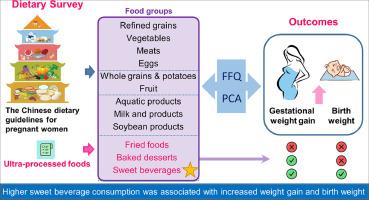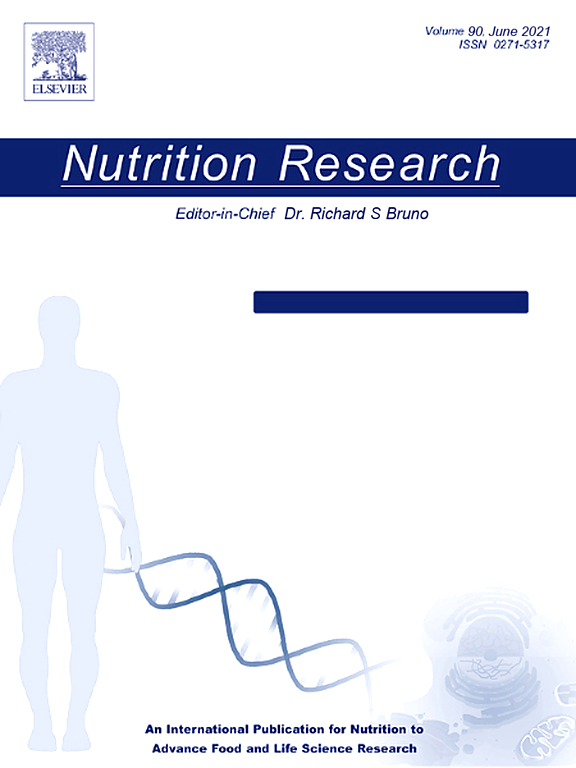Higher sweet beverage consumption was associated with increased gestational weight gain and birth weight: A Chinese cohort study
IF 3.1
3区 医学
Q2 NUTRITION & DIETETICS
引用次数: 0
Abstract
Diet during pregnancy is crucial to maternal metabolism and fetal development, so exploring the most potent food risk factor could improve maternal and child health. In this study, we investigated the diet and lifestyle of 833 healthy pregnant women in the second trimester from November 2020 to August 2021. Based on the Tianjin Antenatal Care System in China, we followed up with these women and recorded their gestational weight gain (GWG) and newborn birth weight. We conducted a dietary survey through FFQ based on the food groups recommended by the Chinese Dietary Guidelines and included common ultra-processed foods. We collected 219 semi-quantitative FFQs and 614 self-reported FFQs for analysis. According to the consumption frequency of 12 food groups, 4 dietary patterns were extracted by principal component analysis. We analyzed the associations of food energy, consumption frequency, and dietary patterns with GWG and birth weight, especially GWG in the first and second trimesters (f-GWG). The results showed that f-GWG was positively correlated with food energy. Beverage consumption was associated with f-GWG (r = 0.288, P = .026) in obese pregnant women. A dietary pattern that favors high consumption of ultra-processed foods (fried foods, baked desserts, and sweet beverages) was associated with increased GWGs. Non-obesity women with high consumption of baked desserts and sweet beverages had higher GWGs (P < .05). After adjusting for confounding factors (including total energy, physical activity, and sleep quality), only sweet beverage consumption was associated with f-GWG (β 0.498, 95%CI 0.153-0.843) and birth weight (β 0.124, 95%CI 0.009-0.240). Sweet beverage consumption is a key adjustable risk factor for prenatal care.

甜饮料消费量增加与妊娠体重增加和出生体重增加有关:一项中国队列研究
孕期饮食对母体的新陈代谢和胎儿的发育至关重要,因此,探索最有效的食物风险因素可以改善母婴健康。在这项研究中,我们调查了 833 名健康孕妇在 2020 年 11 月至 2021 年 8 月期间的后三个月的饮食和生活方式。在中国天津产前保健系统的基础上,我们对这些孕妇进行了随访,并记录了她们的妊娠体重增加(GWG)和新生儿出生体重。我们根据《中国居民膳食指南》推荐的食物类别进行了膳食调查,其中包括常见的超加工食品。我们收集了 219 份半定量 FFQ 和 614 份自报 FFQ 进行分析。根据 12 种食物的摄入频率,通过主成分分析提取出 4 种膳食模式。我们分析了食物能量、摄入频率和膳食模式与体重指数和出生体重的关系,尤其是妊娠头三个月和后三个月的体重指数(f-GWG)。结果显示,f-GWG 与食物能量呈正相关。肥胖孕妇的饮料消耗量与 f-GWG 相关(r = 0.288,P = .026)。偏爱大量食用超加工食品(油炸食品、烘焙甜点和甜饮料)的饮食模式与 GWG 的增加有关。大量食用烘焙甜点和甜饮料的非肥胖妇女的总血糖值更高(P < .05)。在对混杂因素(包括总能量、体力活动和睡眠质量)进行调整后,只有甜饮料消费与 f-GWG (β 0.498,95%CI 0.153-0.843)和出生体重(β 0.124,95%CI 0.009-0.240)相关。饮用甜饮料是产前护理的一个关键可调整风险因素。
本文章由计算机程序翻译,如有差异,请以英文原文为准。
求助全文
约1分钟内获得全文
求助全文
来源期刊

Nutrition Research
医学-营养学
CiteScore
7.60
自引率
2.20%
发文量
107
审稿时长
58 days
期刊介绍:
Nutrition Research publishes original research articles, communications, and reviews on basic and applied nutrition. The mission of Nutrition Research is to serve as the journal for global communication of nutrition and life sciences research on diet and health. The field of nutrition sciences includes, but is not limited to, the study of nutrients during growth, reproduction, aging, health, and disease.
Articles covering basic and applied research on all aspects of nutrition sciences are encouraged, including: nutritional biochemistry and metabolism; metabolomics, nutrient gene interactions; nutrient requirements for health; nutrition and disease; digestion and absorption; nutritional anthropology; epidemiology; the influence of socioeconomic and cultural factors on nutrition of the individual and the community; the impact of nutrient intake on disease response and behavior; the consequences of nutritional deficiency on growth and development, endocrine and nervous systems, and immunity; nutrition and gut microbiota; food intolerance and allergy; nutrient drug interactions; nutrition and aging; nutrition and cancer; obesity; diabetes; and intervention programs.
 求助内容:
求助内容: 应助结果提醒方式:
应助结果提醒方式:


